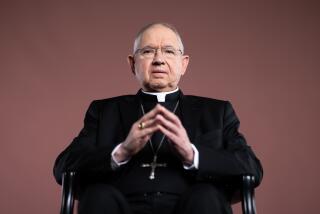Cardinal Paul-Emile Leger; Left Post to Work in Africa
- Share via
MONTREAL — Cardinal Paul-Emile Leger, considered a papal candidate until he left his post as archbishop of Montreal to work in squalor as an African missionary, died Wednesday. He was 87.
Leger was admitted to the Hotel-Dieu Hospital in Montreal last week after suffering an asthma attack. Hospital officials said he died of respiratory complications.
In 1967, he left the panoply of church trappings to live for more than a decade in a construction trailer next to a Cameroon hospital that he built to treat handicapped children.
When he returned to Montreal 12 years ago in frail health, he set up the Jules and Paul-Emile Leger Foundation, a relief agency that raises and distributes $12 million a year to the Third World in his name and that of his only brother, former Governor-General Jules Leger.
Named archbishop of Montreal in 1950, he reigned over Canada’s largest diocese at a time when the church was the most important institution in the lives of French-speaking Canadians.
In 1953, Pope Pius XII named Leger a cardinal, but many were shocked 14 years later when Leger abandoned the prestige of his office to live in the African bush.
After 12 years abroad, he returned to Canada sick and shocked by the new affluence in Montreal. He took to the airwaves to remind Quebecers of their religious roots. His sense of humor and speaking skills made him a folk hero.
“He was the last (Canadian) priest to have influence on the people,” said Micheline Lachance, who wrote a two-volume biography of Leger.
Leger, who was born at St.-Anicet, 30 miles southwest of Montreal, quit school at the age of 14 because of ill health and tried being a mechanic and a butcher. Five years later, he joined the priesthood.
He taught at a seminary near Paris, established a mission at Fukuoka, Japan, and went to Rome at the end of World War II when “Italy really was the Third World,” he said.
“I began to help the Pope (Pius XII) in finding food and medicine. I can say our relations were not only friendly, but like a father with his son.”
This relationship, he said, was crucial in his appointment as archbishop of Montreal.
In 1952, at the age of 48, Leger became one of the youngest “princes of the church” when Pope Pius XII made him a cardinal.
In 1963, the cardinal toured African leper colonies.
Moved by what he saw, Leger began raising money and resigned from the archdiocese at the age of 63, saying: “I have reached the age where a certain sclerosis of soul and body might set in. The spur must be used to get out of the rut.”
Then he added: “It is individual gestures, though they are often unspectacular, which will make all the difference in the long run.”
When he got to Cameroon, he discovered that the government was already looking after lepers. Instead, he built a hospital for handicapped children, many of them victims of polio, then turned it over to the government on his departure.
In Canada, the government asked him to work with refugees fleeing communist regimes in Southeast Asia. He visited camps along the Thai-Cambodia border as a 75-year-old cardinal, returned on a jet filled with refugees, and was hospitalized immediately for exhaustion.
More to Read
Sign up for Essential California
The most important California stories and recommendations in your inbox every morning.
You may occasionally receive promotional content from the Los Angeles Times.










